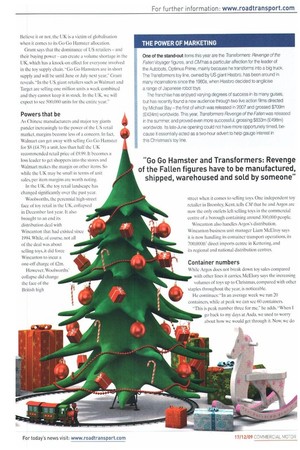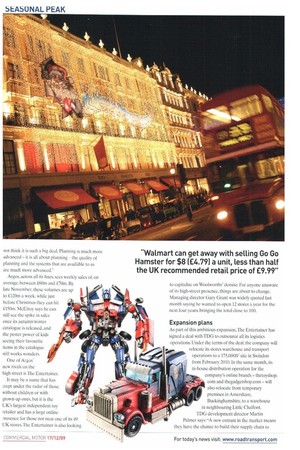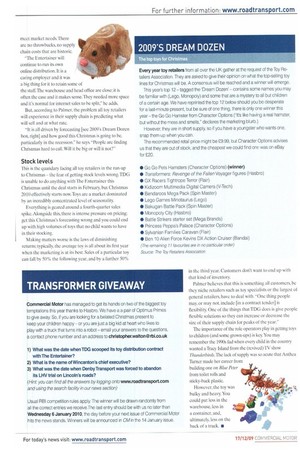Opening the toy box
Page 48

Page 49

Page 50

Page 51

If you've noticed an error in this article please click here to report it so we can fix it.
From factory floor to Christmas stockings, the transport industry plays an integral part in making every child's dreams come true this time of year. CM reveals the journey some of 2009's top toys will be taking.
Words: Christopher Waitoo Anyone who works in the road transport industry will at least be familiar, if not directly involved, with the Christmas peak.
Even in a bad year (and 2009 has been a very bad year), consumer volumes will accelerate in time for Christmas, and nothing illustrates that peak more than toys.
It would be wonderful to believe thal a kindly Father Christmas dropped toys down the chimney of every good child in the land on Christmas Eve. But the truth is, in our globalised world, the Go (in Hamster and Transformers: Revenge of the Fallen action figures -just two of the Toy Retailers Association's top 12 toys for Christmas have to be manufactured, shipped. warehoused and sold by someone.
This year's top toys for Christmas are derived from the canvassed opinions of Britain's toy retailers (see '2009's Dream Dozen' box on page 51), but the art of making sure this year's hot item appears on the shelves or websites before Christmas is often out of the hands of your average logistics supplier.
As is typical these days, the majority of toys are manufactured in China.
For retailers, this means orders have to be in early because there is a 6)-day lead time to make the toys, 28 days shipping and whatever your final distribution times are from the point where the containers arrive on UK shores.
The Toy Retailers Association's Stuart Grant says that for toy retailers which have 50% of their sales weighted to the final three months of the year Christmas starts in July. -Hie big catalogues come out in July for orders, and most manufacturers will TV advertise for a short burst to get their readings for Christmas," he says. -At that point in July, you are looking at getting stock by the end of September or the beginning of October for Christmas.
"That is generally how the industry tracks, but, for example, you will not get a read on how an item such as a kid's digital camera will go."
Supply and demand
You could be forgiven for thinking that it is the retailer's fault if there is not enough stock for this year's hot item, This year's must-have Christmas toy is the Go Go Hamster, but the lack of supply compared with demand is not down to retailers' orders. Believe it or not, the UK is a victim of globalisation when it comes to its Go Go Hamster allocation.
Grant says that the dominance of US retailers and their buying power can create a volume shortage in the UK. which has a knock-on effect for everyone involved in the toy supply chain. "Go Go Hamsters are in short supply and will be until June or July next year,Grant reveals. "In the US. giant retailers such as Walmart and Target are selling one million units a week combined and they cannot keep it in stock. In the UK, we will expect to see 500,000 units for the entire year."
Powers that be
As Chinese manufacturers and major toy giants pander increasingly to the power of the US retail market, margins become less of a concern. In fact, Walmart can get away with selling Go Go Hamster for $8 (£4.79) a unit, less than half the UK recommended retail price of £9.99. It becomes a loss leader to get shoppers into the stores and Walmart makes the margin on other items. So while the UK may be small in terms of unit sales, per item margins are worth noting.
In the UK. the toy retail landscape has changed significantly over the past year.
Woolworths, the perennial high-street face of toy retail in the UK, collapsed in December last year. It also brought to an end its distribution deal with Wincanton that had existed since 1994. While, of course, not all of the deal was about selling toys, it did force Wincanton to incur a one-off charge of £.2m. However, Woolworths' collapse did change the face of the British high street when it comes to selling toys. One independent toy retailer in Bromley, Kent, tells CM that he and Argos are now the only outlets left selling toys in the commercial centre of a borough containing around 300,000 people.
Wincanton also handles Argos's distribution. Wincanton business unit manager Liam McElroy says it is now handling its container transport operations, its 700,000ft2direct imports centre in Kettering, and its regional and national distribution centres.
Container numbers
While Argos does not break down toy sales compared with other lines it carries. McElory says the increasing volumes of toys up to Christmas, compared with other staples throughout the year, is noticeable.
He continues: "In an average week we run 20 containers, while at peak we can sec 60 containers.
This is peak number three for me,he adds. "When I go hack to my days at Asda, we used to worry about how we would get through it. Now, we do
not think it is such a big deal. Planning is much more advanced it is all about planning the quality of planning and the systems that are available to us are much more advanced."
Argos, across all its lines, sees weekly sales of, on average. between £60m and £70m. By late November. these volumes are up to /120m a week, while just before Christmas they can hit £150m. McElroy says he can still see the spike in sales once its autumn/winter catalogue is released, and the pester power of kids seeing their favourite items in the catalogue still works wonders.
One of Argos' new rivals on the high street is The Entertainer.
It may he a name that has crept under the radar of those without children or with grown-up ones, but it is the UK's largest independent by retailer and has a large online aresence for those not near one of its 49 UK stores. The Entertainer is also looking to capitalise on Woolworths' demise. For anyone unaware of its high-street presence, things are about to change. Managing director Gary Grant was widely quoted last month saying he wanted to open 12 stores a year for the next four years, bringing the total close to 100.
Expansion plans As part of this ambitious expansion, The Entertainer has signed a deal with TDG to outsource all its logistics operations. Under tlu., terms of the deal, the company will relocate its stores warehouse and transport operations to a 175,000ff2 site in Swindon from February 2010. In the same month, its in-house distribution operation for the company's online brands thetoyshop. corn and thegadgetshop.com will also relocate from temporary premises in Amersham, Buckinghamshire, to a warehouse
in neighbouring Little Chalfont. TDG development director Martin Palmer says: "A new entrant in the market means they have the chance to build their supply chain to meet market needs. There are no throwbacks, no supply chain costs that are historic.
"The Entertainer will continue to run its own online distribution. It is a caring employer and it was a big thing for it to retain some of the staff. The warehouse and head office are close; it is often the case and it makes sense. They needed more space and it's normal for internet sales to he split," he adds.
But, according to Palmer, the problem all toy retailers will experience in their supply chain is predicting what will sell and at what rate.
"It is all driven by forecasting [see 2009's Dream Dozen box, right] and how good this Christmas is going to be, particularly in the recession," he says "People are finding Christmas hard to call. Will it be big or will it not?"
Stock levels
This is the quandary facing all toy retailers in the run-up to Christmas the fear of getting stock levels wrong. TDG is unable to do anything with The Entertainer this Christmas until the deal starts in February, but Christmas 20.10 effectively starts now. Toys are a market dominated by an incredibly concentrated level of seasonality.
Everything is geared around a fourth-quarter sales spike. Alongside this, there is intense pressure on pricing; get this Christmas's forecasting wrong and you could end up with high volumes of toys that no child wants to have in their stocking.
Making matters worse is the laws of diminishing returns; typically, the average toy is all about its first year when the marketing is at its best. Sales of a particular toy can fall by 50% the following year, and by a further 50% in the third year. Customers don't want to end up with that kind of inventory.
Palmer believes that this is something all customers, be they niche retailers such as toy specialists or the largest of general retailers, have to deal with. -One thing people may, or may not. include [in a contract tender] is flexibility. One of the things that TDG does is give people flexible solutions so they can increase or decrease the size of their supply chain for peaks of the year.
The importance of the role operators play in getting toys to children (and some grown-ups) is key. You may remember the 1990s fad when every child in the country wanted a Tracy Island from the (revived) TV show Thunderbirds. The lack of supply was so acute that Anthea Turner made her career from building one on Blue Peter from toilet rolls and sticky-back plastic.
However, the toy was bulky and heavy. You * could put less in the warehouse, less in a container, and, ultimately, less on the back of a truck. •
























































































































































